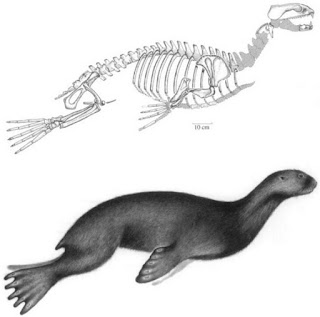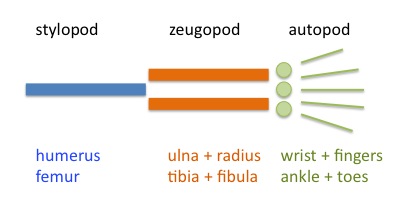Barbarian observes:
Of course it is.
If it's all "common design", why not use it for mammals?
Again, having a common designer does not necessitate using the same design for all of any type of creature…
So, we're back to (shrug) "God must have done it that way."
Perhaps if YOU were the common designer you would have used a “common design” for all mammals.
If I were the Creator, I would use the marvelous universe I had created, to make organisms by natural means. Which is what He did.
Now all living things have some areas of genetic similarity and for most of them we have zero clue as to why they are there
The important thing is that genetic relationship always shows common descent. As you learned, the family tree discovered by Linnaeus was confirmed by genetic evidence, which as we now realize, indicates ancestry. We use it today for just that purpose. And it always works.
Even more convincing, evolutionary development has shown how existing genes in primitive organisms have become modified in later organisms to new uses and forms. This is completely incomprehensible to creationists.
Barbarian observes:
We keep hearing creationists talk about "common design", but then when it's time to look at specifics, they don't want to talk about it.
Most of the ID movement's scientists only speak of the indications of design (not a "common" design) and some designs have features in common (like the presence of DNA in all living things to encode FUNCTIONAL proteins)
Let's take a look. From the guys who invented the doctrine of ID:
"Bat and Whale Echolocation Genes Point to Common Design"
http://www.discovery.org/multimedia...le-echolocation-genes-point-to-common-design/
"The failure of the tree of life points to common design"
http://www.discovery.org/f/9471
If you'd like me to show you why those two beliefs are hooey, I'd be pleased to do that, but note that "common design" is a key doctrine in their new religious movment.
Barbarian observes:
Creationists can only say "God did it", but evolutionary theory makes it clear why this is so.
Then according to your idea of evolution why did God do it (IYO of course)?
It's not a religious idea. Evolutionary theory points out that feathers aren't going to be found on mammals, because mammals evolved from reptiles that did not have them, and birds have feathers because they evolved from reptiles that did have them. As far as why God uses nature to create things, it seems to me that is the reason He made nature.
But you framed the question in such a way it implies Evolution explains WHY God did it,
No. I merely showed you that science can demonstrate why mammals don't have feathers, and birds do.
and when your other, sincerely held yet dissonant, belief comes out, you say Evolution is HOW He did it.
Anyone who accepts God's word as it is, would realize that evolution is completely consistent with His creation.
Evolutionary theory points out that feathers aren't going to be found on mammals, because mammals evolved from reptiles that did not have them, and birds have feathers because they evolved from reptiles that did have them. As far as why God uses nature to create things, it seems to me that is the reason He made nature.
And you clearly totally miss the conflict you walk in.
It's a conflict only for those who add the man-made doctrine of YE creationism to their beliefs. It's never been a problem for Christian belief.
You can take Christianity as it has always been, or you can add YE creationism to it. Pick a stand and go with that but flip flopping only makes you seem political in purpose.
Barbarian regarding fossil seals:
Only if you assert that pinnipeds must not have legs. But this one does. Suppose you argued that birds must not have teeth. Would this be a bird?
Not even closely relevant!
Precisely relevant. I use it, knowing that creationists have declared Archaeopteryx a bird, even though it has structures not found in birds today. Just as this fossil pinniped has structures not found in pinnipeds today.
A bird by definition is a warm-blooded egg-laying vertebrate distinguished by the possession of feathers, wings, and a beak, that is typically able to fly.
Archaeopteryx lacks a beak, just as Puilija lacks flippers. So you see, it's a very good analogy.
Could a bird have no feathers or wings, be cold-blooded and beakless?
Beakless, yes. Now, if Puijila was cold-blooded, hand no hair, or limbs, I'd agree that it would not be a pinniped. But as you see, it's a pinniped, only without flippers, just as Archaeopteryx is a bird only without a beak.
Barbarian observes:
In a way, since birds still have arms and hands, albeit greatly modified and reduced
Hypothesis based assumption
Observable fact. The same genes, the same structures, the same embryonic development. Homology.
…but if you want to believe wings are a type of arms and hands I guess I cannot persuade you of how utterly ridiculous that is.
See above. Humerous, ulna, radius, metacarpals, phalanges. All from the same genes and structures that make up your arms and hands. No point in denying it.
but pinnipeds however, by definition (the very reason they were called this), do not have fully developed front and rear legs and feet.
No pinniped today has them, just as no bird today has teeth. But both of them retain the genes and rudiments of those things.
And what are the genes for pinniped fully developed legs and feet to which you are referring?
They are the same as for other mammals, modified slightly, as they are for various other lines.
I do not believe we have isolated or identified any such genes with any sense of assurance but I would love to see their best guess….can you show me this?
One example:
Natural selection acts on variation within populations, resulting in modified organ morphology, physiology, and ultimately the formation of new species. Although variation in orthologous proteins can contribute to these modifications, differences in DNA sequences regulating gene expression may be a primary source of variation. We replaced a limb-specific transcriptional enhancer of the mouse Prx1 locus with the orthologous sequence from a bat. Prx1 expression directed by the bat enhancer results in elevated transcript levels in developing forelimb bones and forelimbs that are significantly longer than controls because of endochondral bone formation alterations. Surprisingly, deletion of the mouse Prx1 limb enhancer results in normal forelimb length and Prx1 expression, revealing regulatory redundancy. These findings suggest that mutations accumulating in pre-existing noncoding regulatory sequences within a population are a source of variation for the evolution of morphological differences between species and that cis-regulatory redundancy may facilitate accumulation of such mutations.
http://www.ncbi.nlm.nih.gov/pmc/articles/PMC2192750/
Notice that the same genes operate in all mammals for this. There are three zones for limb formation:
Stylopod (humerus) zeugopod (ulna radius) and autopod (wrist/digits) each has a different set of genes that affect timing.
This was an artistic creation of a kind of raptor.
No. I assume you meant Archaeopteryx. The fact that that bird lacks a beak much as the primitive seal lacks flippers points out the problem creationists have with these homologies. If Archaeopteryx is a bird, then Puijila is a seal. Moreover, I showed you another transitional between Puijila and modern seals, showing a gradual change over time.
The resultant conclusion is the mythos of homology
Homology is a fact, as shown by Owen (who did not accept evolution) coining the term, without realizing the evolutionary implications of such homologies.
as it applies to a few (very limited) similarities....
Bad assumption, that. There are countless homologies in living things. Would you like to learn about some of them?
if you want to go here (more of the bait and switch) then start a new thread....we are talking about this ancient creature you called a manatee....
Because it has all the marks of a manatee, just with legs, it is a manatee, much as Archaeopterix is a bird, even though it has teeth.










